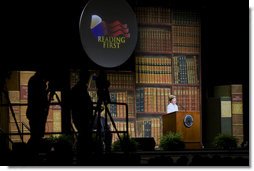
 |
For Immediate Release
Office of the First Lady
July 28, 2008
Mrs. Bush's Remarks at the Fifth Annual Reading First National Conference
Gaylord Opryland Resort and Convention Center
Nashville, Tennessee
11:50 A.M. CDT
MRS. BUSH: Thank you all. Thank you very much for that very warm welcome. And I want to thank Ray for his good work at the Department of Education. I'm very happy to be here at the Fifth Annual National Reading First Conference in Nashville, Tennessee. (Applause.)
But before we talk about reading, and because we are in Nashville, I want to extend to the people of Tennessee our sympathy on the loss of life yesterday at a Knoxville church. And I know I speak for everyone here when I say that those injured and the families of those killed are in our thoughts and prayers.
 I want to recognize from the U.S. Department of Education the Director of
the Academic Improvement and Teacher Quality Programs and Reading First,
Dr. Joe Conaty. Thanks, Joe. Applause.)
I want to recognize from the U.S. Department of Education the Director of
the Academic Improvement and Teacher Quality Programs and Reading First,
Dr. Joe Conaty. Thanks, Joe. Applause.)
Thanks also to Ray Simon, the Deputy Secretary of Education. Ray is a very good speaker, and you were very funny and fun to just get to hear, and you were so sensible. Isn't it sensible to teach kids to read? (Applause.)
And then especially to everyone in the audience, the reading teachers, the reading coaches, the principals, the administrators -- each one of you who are working to teach American children to read. (Applause.)
Thirty million American adults -- one out of every seven in our nation -- lack everyday reading skills. For these men and women, filling a prescription or filling out an application for a job can be a daunting task. Poor readers are much more likely to have health problems, and they're much less likely to have jobs. As President Bush has said, "If you can't read, you can't realize the great American dream."
America's literacy problem is not going away. The National Commission on Adult Literacy reports that the United States is the only country in the OECD, which is the Organization for Economic Cooperation and Development, whose young adults are less educated than those in previous generations. We all know in this room that the most effective way to address this problem is to make sure all American children learn to read, and read well.
Reading First is based on the premise that there's no limit to what children who know how to read can achieve. Reading First is a signature component of No Child Left Behind and the largest early reading initiative in our nation's history. It targets the children who need the most help, including students from low-income families and English language learners.
And it's founded on sound science -- not the latest fads. The nonpartisan National Research Panel reviewed more than 100,000 studies before identifying the five components that form the core of the Reading First initiative.
Using data and research to guide decision-making has been standard practice in medicine, in business, and even in advertising for decades. We're just beginning to use research-based practices in education -- and on behalf of students, parents, and teachers, thank goodness we are. (Applause.)
 As Secretary Spellings likes to say, "We would never ask a doctor to learn
surgery on the operating table." Our teachers have the right to expect the
same level of professional development. And as a direct result of Reading
First grants, more than 100,000 teachers across the country have been
trained to implement high quality, scientifically based reading programs.
This emphasis on staff development is key to Reading First's success.
As Secretary Spellings likes to say, "We would never ask a doctor to learn
surgery on the operating table." Our teachers have the right to expect the
same level of professional development. And as a direct result of Reading
First grants, more than 100,000 teachers across the country have been
trained to implement high quality, scientifically based reading programs.
This emphasis on staff development is key to Reading First's success.
But just as we would expect our doctors to have good training, we would also insist that they diagnose an illness with testing results to see what's wrong. Testing is an important part of teaching, as well, and it's an important component of Reading First. Too often in the past, because we didn't assess, we moved children from first grade to second grade to third grade -- until they ended up in the ninth grade unable to read even basic sentences. And, as every teacher in this room knows, it's not unfair to expect third-grade students to read at a third-grade level. In fact, it's our obligation. (Applause.)
Each of you has seen firsthand how effective Reading First can be. Reports show that Reading First students from nearly every grade and subgroup have made impressive gains in reading proficiency. In Virginia, educators in Norfolk and Newport News saw -- are there some of them here? -- (laughter) -- saw third-grade reading comprehension improve by 20 percent over the last three years. Maryland, Minnesota, South Dakota, and Montana have seen statewide reading gains of 10 percent or more.
These statistics show that Reading First is achieving results in schools across the nation -- schools like William Walker Elementary School in Oregon. (Applause.) William Walker once had the second-to-lowest reading scores of the 31 elementary schools in the Beaverton School District. Sixty-three percent of its third and fifth graders met state reading standards in 2004. That figure has now increased to more than 86 percent. (Applause.)
Principal Barbara Evans describes herself as a "true advocate" of the Reading First program. She explains that staff -- that the staff development her school receives under the program is incredible. Reading First is encouraging her students [sic] to collaborate and to monitor students' progress regularly. "Assessing once or twice a year is not enough," she says. "By continually measuring progress, her teachers can put interventions into place immediately that help struggling students meet their goals."
Dr. Caroline Winchester, the superintendent of Loup City Public Schools in Nebraska says Reading First "enables our high performers to excel at higher levels and our struggling students to receive intensive instruction." She tells the story of one child who graduated kindergarten unable to meet the benchmark of identifying sounds. "After a year and a half of our new core program and training purchased with Reading First dollars," she said, "this child is a fluent reader and is the best in his group." The school psychologist noted that this student interacts more positively with his teachers and peers because he has learned to read.
Each of you have your own stories of success in your own schools. Yet despite evidence that the program is effective, Congress last year cut Reading First funding by 60 percent. Now appropriators in the House and Senate are proposing to eliminate this program altogether.
If Congress continues on this path, it would be the first time in a decade that no federal money would be provided for reading instruction. The solution for our nation's struggling students is not less time and fewer resources. Congress must restore the full $1 billion appropriation for Reading First. (Applause.)
As you hear today from the experts and from your colleagues, please take time to think how you can help spread the word about Reading First. This historic program is a lifeline for over a 1, 800,000 of America's most vulnerable students. With your help, we can ensure that Reading First supports millions more American children over the years to come.
Thank you all very, very much. And God bless your good work. (Applause.)
END 12:00 P.M. CDT